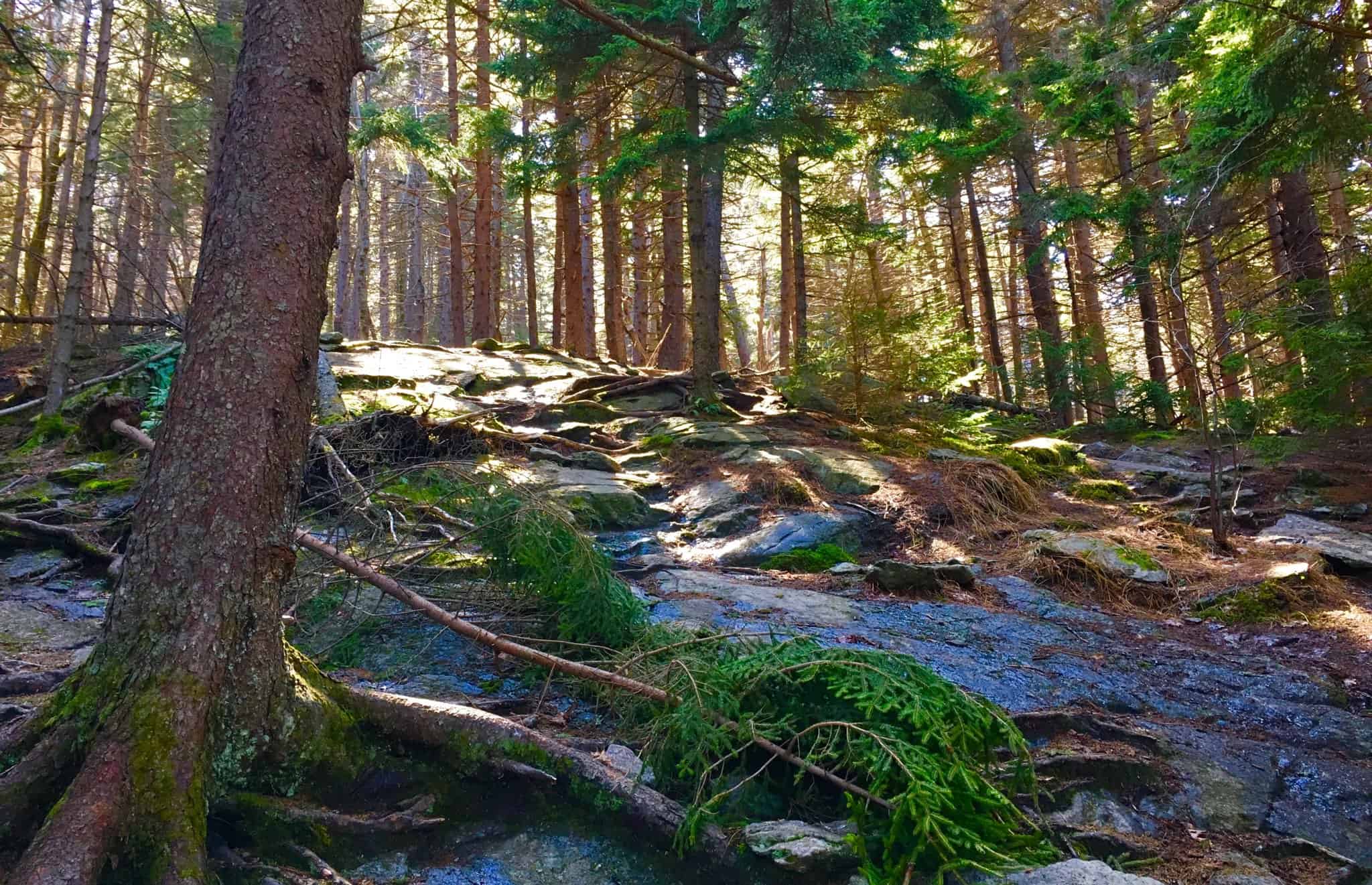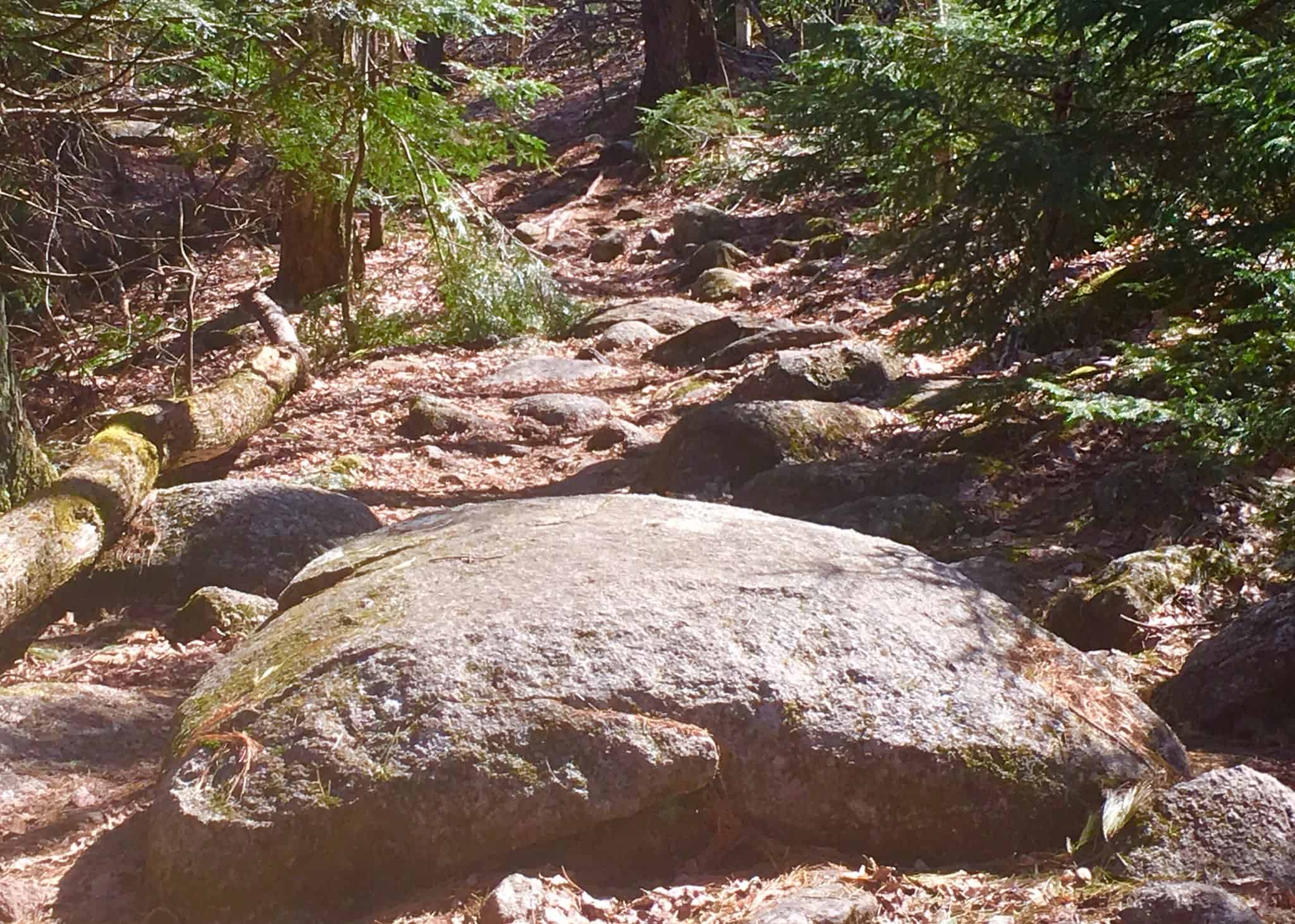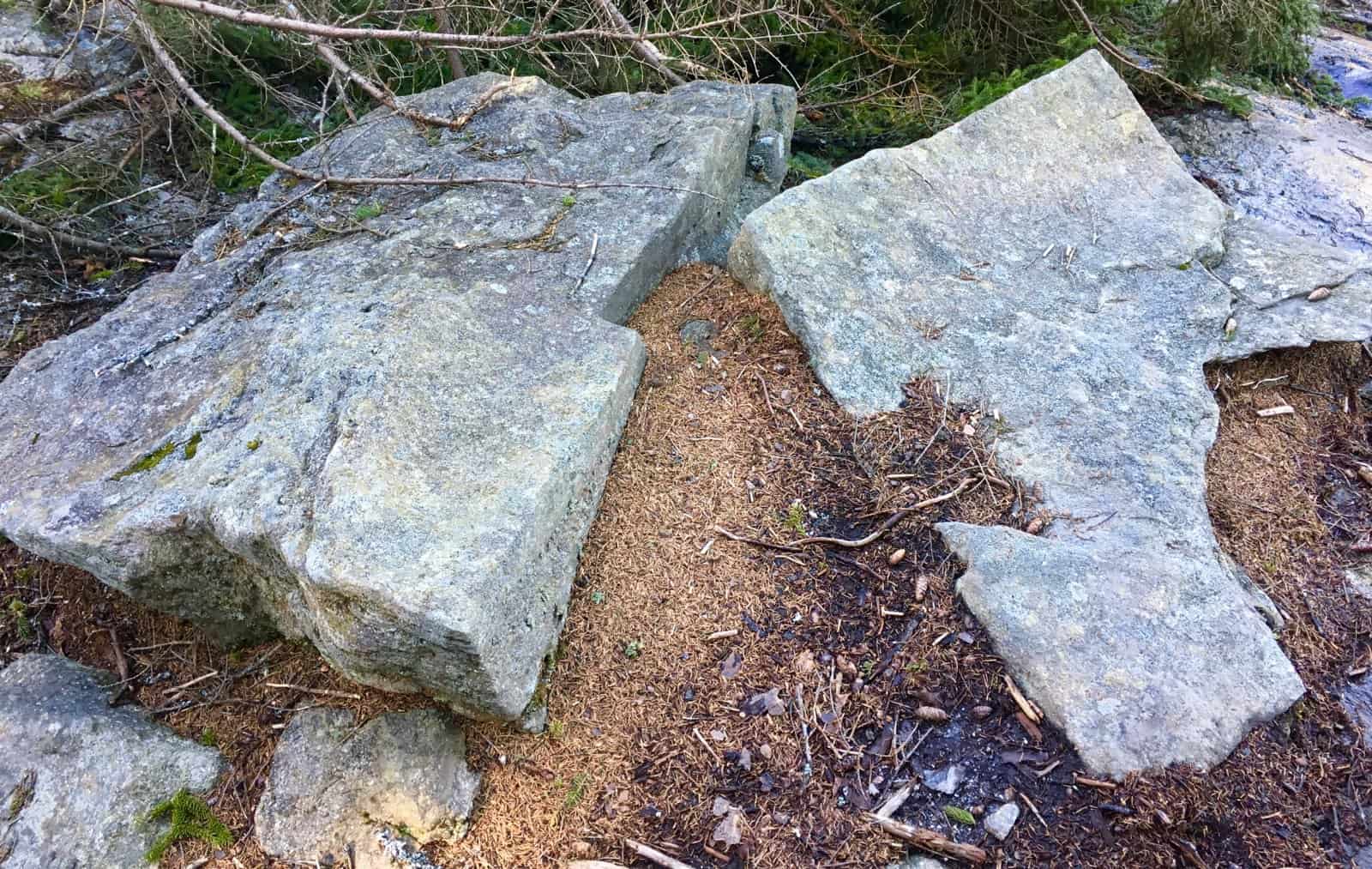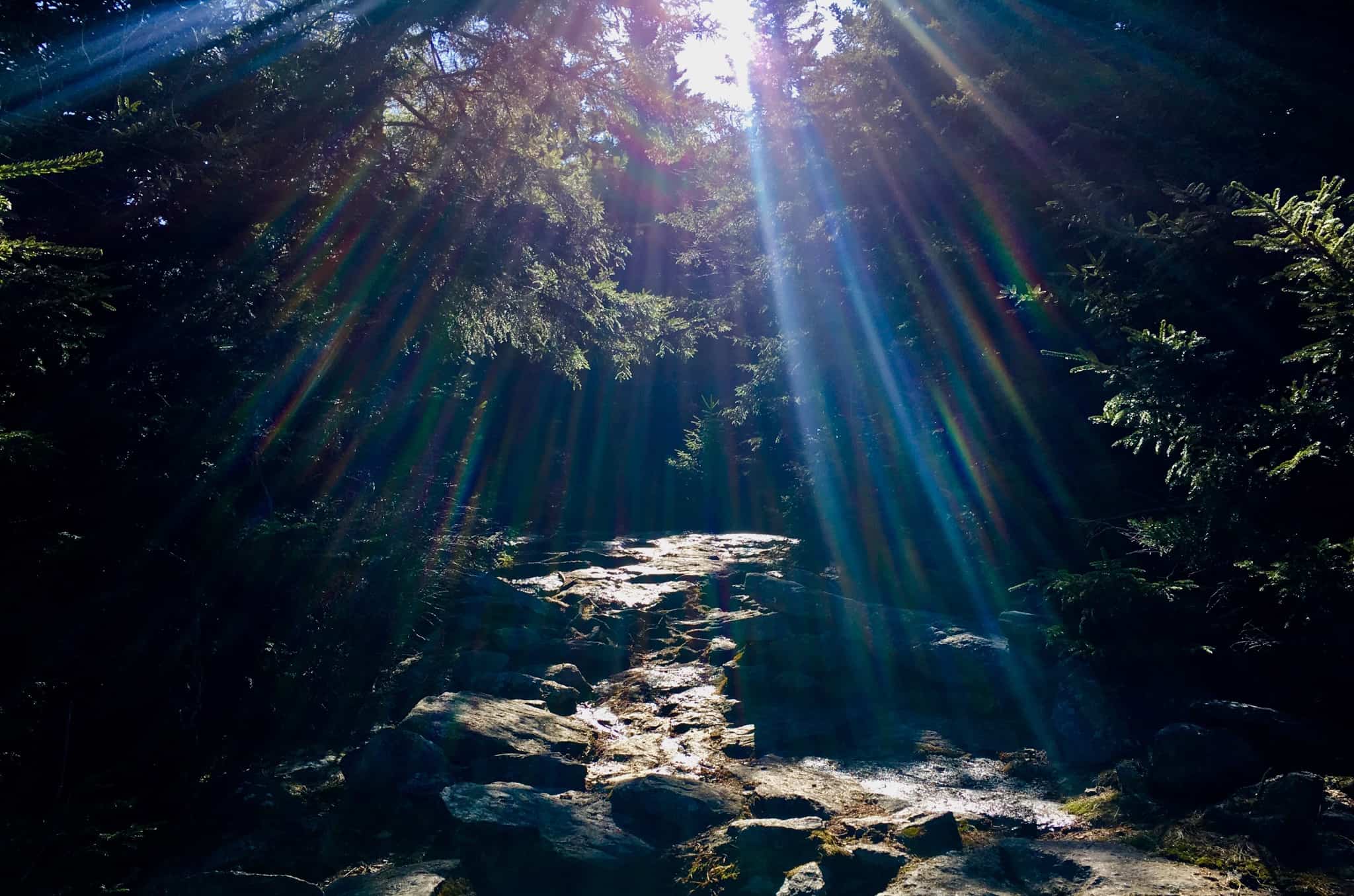North-Pack Monadnock Mountain

Elevation: 2,300ft
Location: Greenfield New Hampshire/USA
Note1: It is hard to write lately. Spring is here, but its pretty hard to feel.
This is usually the time of year that I’m pretty psyched, where I’m making plans, studying maps, getting strong. The lull and strangeness of life under quarantine, and social distancing, has thrown everybody off. Most importantly, there are people who are sick, and some who have passed away, and it is sharply disheartening. I think to myself: “How can I write of my love of newly explored mountain ranges, without seeming somewhat tone-deaf…”
And then I realize…
This is absolutely the most important time to write of my deep love for mountain ranges, and all the mysteries therein. I want to charge-up people to get out there. So I keep writing. Plus, I have something new to share, something special, rugged, and beatific. New Hampshire, USA.
New Hampshire is truly special, for more reasons than I had previously known. The stones here, are incredible. The forests, intimidatingly dense, even by Colorado Rockies, or Sierra Nevada standards. 
Now, more than ever, people need to experience rolling hills, and rocky heights!
Note2: Aware of the seriousness of the conflicts looming in the valleys of the world down below, I’ve wandered into the hills of New Hampshire merely to cope with what my heart is telling me. And right on time, I’ve discovered the Hillsborough-Small-Mountain Range, here in southern New Hampshire. This is a place of magical beauty, strong signs of profound Neolithic history, and scenes with so much old stone, and alpine moss, that at times I feel I am back in the forests of Blacklion, Ireland, drifting along the glowing, moss-engrossed forest glades. (Image/Below)
A symmetry-conscious look at this very image below, ‘flips a switch’ in my thinking; the same switch that has sent me packing out to the Highlands of Scotland, the Sierra Nevada’s of California, and Irelands incredible Ranges; searching for the incredible angular-codes in the stones. There are parallels, directional indicators, centricity, apex’s, alignments, magnetic orientations, massive irrigated engineering zones, interlocking-fixtures, and statements that are cut literally into the faces of full Standing Stones, in specific locations across the world.(Mt.Watatic/Massachusetts Standing Stone/Images/Right).

New Hampshire is absolutely part of this epic story, and it is on full display, from mountain to forest to stream. (Megalith found along the stone-lining at Wapack’/Image/Below). It is a cut megalith on its surface, on an exact a parallel plane, in direct accordance with the nearest, flatly-cut surface, of the foreground boulder)

Note3/Trail: The Trail to climb North-Pack-Monadnock-Mountain is found by drifting into the Wapack National Wildlife Refuge pathway, in Greenfield New Hampshire. You can find the trail on the edge of the Forest, cascading down onto ‘Mountain Road’. There is so much stone in this region, from the lower valleys, to the stone-linings running all the way up to the peaks, that I was utterly stunned. The forest here is an abyss of verdant tops, layers of green-upon-green, where from above, nothing might be seen of the stones, and their presence, but from beneath, a Neolithic world is abundant. (Image/ New Hampshire Forest/Below) Beneath the rolling massive canvas of leaves, each and every peak in New Hampshire (Image/Below/Right) is inundated with anthropologically-geological statements, cut stones, aligned with the rocky trails, very similar to the Mourn Mountains of Ireland, (Image/Below/Left).
Beneath the rolling massive canvas of leaves, each and every peak in New Hampshire (Image/Below/Right) is inundated with anthropologically-geological statements, cut stones, aligned with the rocky trails, very similar to the Mourn Mountains of Ireland, (Image/Below/Left).
 -Lets take a moment to define what “anthropologically-geological” means, and specifically why we do not attribute these stone-works to Native American, or Celtic Tribes.
-Lets take a moment to define what “anthropologically-geological” means, and specifically why we do not attribute these stone-works to Native American, or Celtic Tribes.
I realize it’s a mouthful; the term: “anthropological geology”. But all that means, is that these stones were intentionally crafted by someone at the earliest point in history; someone capable of incredible strength, judging from the statement they left behind, but also capable of incredible engineering and intellect, represented in stone.
 CULTURAL NOTE:
CULTURAL NOTE:
Identifying Fixtures And Cultures: There is a scientific process for identifying anthropological-geological fixtures in the landscape. We are most likely identifying the first culture on Earth, as hard as that is to swallow. This can be a raw challenge for so many people to accept, but accrued evidence points to this conclusion. To give you some historic context, These global stone statements are pre-Mycenaean, pre-Egytian, pre-Native American, and pre-Celtic. If you are lucky enough to encounter South American Native-wisdom-keepers, in Peru; the Mashco-Piro or Nanti Tribes clearly express that the earliest megalithic stones, at the base of various structures at Macchu Picchu, Indigenous tribes will tell you, in no-certain terms, that the ancestors did not build them. The megaliths were already there when the earliest natives arrived. Other cultures, likeThe Mayans of Mexico, attribute the earliest megaliths, to the gods.
It is also the same for North-Eastern Native-American tribes. Not only are the massive amount of tools required to construct ashlar-cut megaliths, nowhere to be found, but there is absolutely no record, even within the oral tradtion of these seasonally nomadic tribes, of any massive megalithic building-teams. The effort would have to be significant enough to circle the Earth 6 to 7 times! REALLY!? Would’t this effort be the absolute hallmark of the Native Americans in the Northeast? Sorry, but it simply doesn’t exist. Someone else built the stones, before the natives.
To support this premise historically and logically, not one of the Northeastern Native Tribes is called: “The Stone Builders” or “Mountain Lining Buillders”. Not one!?
Instead, northeastern Native American tribes called the original stony trails “the pathways of the gods”. It’s not hard to see why. The Natives understood, and honored, the obvious solar and lunar acclamations of these massive stone-linings, which literally run straight-up the sides of mountains, kinetically-connecting rolling valleys and streams, directly up to the sun-kissed peaks. Countless mountains display this. Just a few blatant examples include: Mt.Monadnock, in Massachusetts where there are Massive Stone Linings to the Peak (Image/Left), +Mt. Bearnagh, Ireland (Image/Right), Mt. Watatic in Massachusetts (Image/2nd Below/Left), Mt Katahdin in Maine (Image/2nd Below/Right) as well as thousands of other examples in the world.
Look at the angle of these stone-lingings, running straight up to the peaks, like connecting cables. It’s so obvious that they are intended to connect and synergize the landscape, like power chords. They are not, and have never been, “walls.” 



These are statements so massive, even with all our modern equipment and digital ability today, we would not be able to do it. To build this amount of intentionally et stones would take Billions, perhaps Trillions of dollars. Imagine the effort?! Are we actually saying that seasonally nomadic North-Eastern Native American tribes, with simple stone pics, spent literally all of their leisure time, when Spring finally came, after long, challenging, and sometimes brutal winters, working against gravity and logic, building “walls”, which literally impede nothing, and exhaust the warriors of the tribe with this work? No. It’s is a fantasy. It simply did not happen. And theorists espousing mis-information that Native Americans did do this, are dead wrong. 
Peer-reviewed study after peer-reviewed study, identifies the seasonal and nomadic nature of Native American tribes in the Northeast. Building massive stone monuments would have been absolutely repugnant to them, and positively the best way for any harshly mandating chief, to get himself beheaded, or banished at best. Ordering the making of “stone walls” which impedes nothing, “walls” nothing, constructing straight up the sides of as many mountains as possible, is absurd in light of North East Native American Culture. It never happened. 
Native American Tribes were, and are, distinctly autonomous, proud, and often at odds with other tribes. If they were out in the forest, completely aloof, voluntarily slaving away, building these stone-“walls”, how could they plant crops, hunt, or be ready to defend themselves from invasive groups in the planting season? Please understand; this does not in any way disrespect the incredibly spiritual beauty, and accomplishments, of the Native American people.
Part of the reason we see them as beautiful, is due to their incredibly minimal, ecologically responsible, imprint upon the landscape. Their attitude was to be part of the landscape, and changing with the seasons; not to build stone-centers, which they would constantly need to defend, in all that permanence. Again, this simply did not happen.
Note4 Trail: Along the initial lower trail at Wapack’, a minor incline weaves into a pristine pathway that leads to a playful set of cascading streams, rolling down the hillsides. (Image/Below) 
There are some really interesting patterns to the note about the pathway itself, as you begin your trek towards the peak. First, it becomes abundantly clear that the higher up in elevation you climb, the more stones you will find embedded into the trail. Secondly, those stones do not look randomly embedded at all. If you observe many of the stones at your feet, it is clear that they have been cut, like scraps from a carpenters table, and dropped into the ground. Thirdly, the trail itself, where the stones are laid, is wound into a specific ‘S’ shape. Why is the distinct area where the stones are found wound into a distinct ‘S’? Why not a straight line to the peak? If the trail was designed by the State, why not the fastest route to the peak. The trail was there before the state ever existed.
 Also, there are massive flat, distinctly oblong, rounded boulder, sitting centrally along the initial trail, radiating the effigy of a snake, winding its way through the woods.(Image/Right+Below) ‘Snake effigy’s’as studied by the excellent research of Matt Adams at New England’s Stones Sites , are currently being researched to be discovered, as an abundant Neolithic meme, found in the patterns of the stones.
Also, there are massive flat, distinctly oblong, rounded boulder, sitting centrally along the initial trail, radiating the effigy of a snake, winding its way through the woods.(Image/Right+Below) ‘Snake effigy’s’as studied by the excellent research of Matt Adams at New England’s Stones Sites , are currently being researched to be discovered, as an abundant Neolithic meme, found in the patterns of the stones.

Note4: It is impossible to lose the trail, due to the stones. It’s that clear. After passing the streams, you will come to a small ledge. You will need to climb for a moment. (Image/Below)
After working your way above the ledge, you have reached the upper shelf of the mountain. There is another half mile of steady, low-incline hiking, before reaching the real pearl of the experience, a plateau of semi-alpine Pine Forest. 
The natural late-afternoon light is tossed through the trees, like slanted pillars, made of light. The stones here tell some sort of story, like peices of a jigsaw puzzle, layed-out sporadically. (4 Images/Below) 



 There are cut-squared slabs, laid side by side, as if to hint at a relationship between the two. There is a full cross-section at the center of the trail, displayed at the rocky edge of the forest above. There are smaller fixtures, fixed perfectly against each other, and cut into apex’s which are also parallel. This is craftsmanship, not mere chance. In addition, the apex’s, or top corners, point directionally to the summit, along the line of the continued trail. That is directionality, and symmetry, as a function of the work of the stones. Another interesting statement of a clearly cut ‘apex-stone’ is found sitting along the trail of the upper forest’s edge (Image/Left) At the moment I found this stone, in mid early April, the Sun was at its highest point in the sky around 1:45. The apex was pointing straight at it. The connection of light to this very spot where I took the photo, created an issue for my camera; but clearly you can see the Sun’s rays, directly above this 4 foot stone, with a 45 degree angle, running parallel, up to an apex section. Perhaps I would not have noticed this if I were a common sojourner, but I have seen this phenomenon many times before, particularly at ancient sites in Western Massachusetts. The comparison to that site is lock-fit. Please compare the two. (Apex-stone at Health Altar Stones/Image/Below)
There are cut-squared slabs, laid side by side, as if to hint at a relationship between the two. There is a full cross-section at the center of the trail, displayed at the rocky edge of the forest above. There are smaller fixtures, fixed perfectly against each other, and cut into apex’s which are also parallel. This is craftsmanship, not mere chance. In addition, the apex’s, or top corners, point directionally to the summit, along the line of the continued trail. That is directionality, and symmetry, as a function of the work of the stones. Another interesting statement of a clearly cut ‘apex-stone’ is found sitting along the trail of the upper forest’s edge (Image/Left) At the moment I found this stone, in mid early April, the Sun was at its highest point in the sky around 1:45. The apex was pointing straight at it. The connection of light to this very spot where I took the photo, created an issue for my camera; but clearly you can see the Sun’s rays, directly above this 4 foot stone, with a 45 degree angle, running parallel, up to an apex section. Perhaps I would not have noticed this if I were a common sojourner, but I have seen this phenomenon many times before, particularly at ancient sites in Western Massachusetts. The comparison to that site is lock-fit. Please compare the two. (Apex-stone at Health Altar Stones/Image/Below)  Other statements, such as directly cut cross-sections, are also found along the upper trail at Wapack’. The first two cross-sections below, the first located on Wapack trail, colored grey; and the second section, colored white, (pictured in a row on the left side below) are both from this Hillsborough Region of New Hampshire. The other sections are from Arizona, Killarney/ Ireland, and western Massachusetts.
Other statements, such as directly cut cross-sections, are also found along the upper trail at Wapack’. The first two cross-sections below, the first located on Wapack trail, colored grey; and the second section, colored white, (pictured in a row on the left side below) are both from this Hillsborough Region of New Hampshire. The other sections are from Arizona, Killarney/ Ireland, and western Massachusetts.






As consistent and mounting evidence continues to build for these X sections, it is becoming hard to dismiss as mere “geological phenomena“. The fact that all of these X sections are found specifically along mountain peak trails is a strong indicator for the idea of engineered landscapes, with distinct memes that identify a single Culture. The meaning of the cross-section is a philosophically mathematical principle, that can be written out, a little dynamic process.
Attributes of the Cross-Section: A cross-section is a centricator. That means it creates a center, symmetry, and distinction, all at once. (Centricated Stone found in Wapack’ Forest/Image/Left)
That means it creates a center, symmetry, and distinction, all at once. (Centricated Stone found in Wapack’ Forest/Image/Left)
The logic is: In order to make any starting mark, the mechanism that person’s mind must use, like a primordial computer program, is the function of centrication. You “find your center’, then make your mark”, so to speak. It is the precursor to all marked expression, just as the Culture that utilized it, and made this symbol their ‘calling card’, is the precursor to all Cultures; the First Culture. I believe that this is the exact reason why we find this particular meme, cut in stone, sometimes in nearly perfect precision, as you can see from the images.
Notes5: The upper forest is the last challenge before making the peak. There is a breeze that comes from the West, through the trees, that can be felt in early April, scented with Pine. Watching a multitude of pines bend in unison to the wind creates a sound impossible to imitate. The green universe literally activates a part of your brain associated with calm, just as blue is associated with cold, or cool.  The last path before the peak is a beautiful and distinct little rocky road, with the Sun within view. there are several stone patches with distinctions that again, have that jigsaw feeling. Some with distinctly cut right angles, (like a literal ‘Right-Angle tool’ of a mason), as well as standing-square blocks, with four clear-cut sides, with giant level-cut boulders in the background, along with the earlier mentioned, apex stone.
The last path before the peak is a beautiful and distinct little rocky road, with the Sun within view. there are several stone patches with distinctions that again, have that jigsaw feeling. Some with distinctly cut right angles, (like a literal ‘Right-Angle tool’ of a mason), as well as standing-square blocks, with four clear-cut sides, with giant level-cut boulders in the background, along with the earlier mentioned, apex stone. 

After a long winter of bad news, and now a stressful quarantine debate , all keeping us indoors too much this season, I may have been a bit more sensitive to the light, than usual for this climb. I was particularly struck by the force of the light of the Sun on this day; the silver and bluish hue pervading the subtle jade needles in the trees. The Sun seemed more like a small silver star looming just above my head. And of course, there it was, lined up centrally, with the small ‘rocky road’, directly above the peak. Only if the path were made of chocolate and pistachio would I have been more delighted by the possible meaning here.
 After about 100 yards, the peak appears like a doorway through the hedge. As you breach the trees there is a small cairn which looks to have been placed as an obvious marker of the peak. The odds are that it is neolithic in origin, and modern in additions.
After about 100 yards, the peak appears like a doorway through the hedge. As you breach the trees there is a small cairn which looks to have been placed as an obvious marker of the peak. The odds are that it is neolithic in origin, and modern in additions.  To the West is a view of Mt. Monadnock, the Senior-sister-Mountain to Wapack’. The distinct straightness of its sides can be distinguished, even from about 2o miles away. It is also inundated with neolithic statements, and reviewed here at Stonestrider.com. Connectivity.
To the West is a view of Mt. Monadnock, the Senior-sister-Mountain to Wapack’. The distinct straightness of its sides can be distinguished, even from about 2o miles away. It is also inundated with neolithic statements, and reviewed here at Stonestrider.com. Connectivity. Wapack is a sacred trail, by all of the standards of this mountaineer. It as a 2,200 foot climb, and fun. There is so much to discover in New Hampshire Hills, and New England. On the way back down I sat and watched the valley below, undulating subtly. I tried to remind myself that what is going on down there, is not of my doing, and never could be.
Wapack is a sacred trail, by all of the standards of this mountaineer. It as a 2,200 foot climb, and fun. There is so much to discover in New Hampshire Hills, and New England. On the way back down I sat and watched the valley below, undulating subtly. I tried to remind myself that what is going on down there, is not of my doing, and never could be.  To readers across the globe, may you find health, wellness, and plenty of sunlight, in the days ahead. Thanks for reading.
To readers across the globe, may you find health, wellness, and plenty of sunlight, in the days ahead. Thanks for reading.